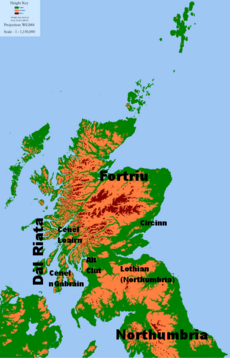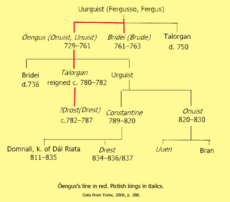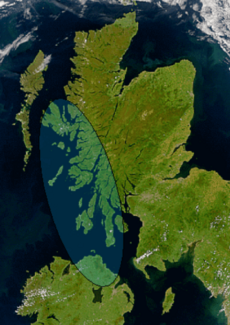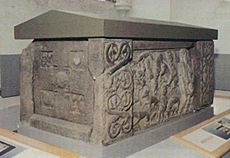Óengus I facts for kids
Quick facts for kids Óengus mac Fergusa |
|
|---|---|
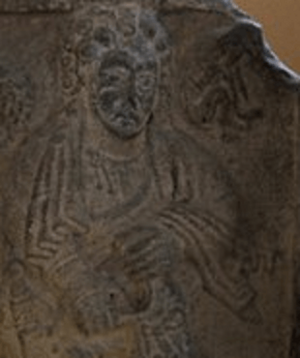
The figure of the Old Testament King David shown killing a lion on the St Andrews Sarcophagus is thought to represent King Óengus. The figure is dressed as a Roman emperor of Late Antiquity and wears a fibula like that of the Emperor Justinian on the mosaic at San Vitale, Ravenna.
|
|
| King of the Picts | |
| Reign | 732–761 |
| Predecessor | Nechtan son of Der-Ile |
| Successor | Bridei mac Fergus |
| Died | c. 761 |
| Burial | St Andrews |
| Issue | Bridei Talorgan |
| House | Óengus |
Óengus son of Fergus (died 761) was a powerful king of the Picts. He ruled from 732 until his death in 761. We know a lot about his time as king from different old writings.
Óengus gained a lot of land, stretching from one coast to the other. Because of his achievements, some people see him as the first king of what would later become Scotland. He took power after a civil war in the late 720s.
He was the strongest ruler in Scotland for over twenty years. Kings from his family ruled Pictland for about a century. This lasted until the Vikings defeated them in 839. That defeat led to a new period of trouble. Eventually, a new Pictish family, led by Cináed mac Ailpín, came to power.
Contents
How Do We Know About Óengus?
What Are the Main Sources?
There are not many original writings from the Picts themselves. We have some old lists of kings. There are also a few stories about how St Andrews was founded. Back then, it was called Cennrígmonaid.
Outside of Pictland, the most helpful writings are the Irish annals. These are like old historical records. The Annals of Ulster and the Annals of Tigernach are the most trusted. They even include notes from a monastery on Iona in Scotland.
Óengus and the Picts sometimes appear in Welsh writings. They are more often mentioned in writings from Northumbria. These include a follow-up to Bede's history and the Historia Regum Anglorum. This last one is thought to be written by Symeon of Durham.
Who Lived in Northern Britain?
In the early 700s, there were four main groups in northern Britain. The Picts lived north of the River Forth. Their land included Orkney, Shetland, and the Western Isles. Before the Viking Age, the kingdom of Fortriu seemed to be the most powerful Pictish area. Important places in Fortriu included Burghead and Craig Phádraig near Inverness.
South of the Forth, down to the River Humber, was the kingdom of Northumbria. It used to be very strong in Britain. But after King Osric died in 729, different families fought for the throne. The growing power of the Mercian kingdom to the south also caused problems. Most of Óengus's reign saw Eadberht Eating as king of Northumbria.
To the southwest of Pictland were the Gaels of Dál Riata. Here, two families, the Cenél Loairn and the Cenél nGabráin, fought over who should be king. In 723, Selbach mac Ferchair gave up his throne. His son Dúngal became king. But Eochaid mac Echdach of the Cenél nGabráin drove Dúngal out in 726. Dúngal and Eochaid were still fighting in 731.
The fourth group was the Britons of Alt Clut. This kingdom later became Strathclyde. Not much is known about their history from this time. King Teudebur map Beli ruled from Dumbarton Rock from 722 until he died in 752. His son Dumnagual then became king.
How Óengus Became King
Óengus was likely from the Mearns area, which was Pictish Circin. He first appears in history near Perth, where he defeated his rival, Alpin, in battle. Óengus was also known as Unust, Unuist, or Onuist. He was the son of Vurguist, or Fergus.
Óengus was already middle-aged when he became famous. He had at least two sons, Bridei (died 736) and Talorgan (died 782). He also had two brothers, Talorgan (died 750) and Bridei (died 763).
King Nechtan son of Der-Ilei gave up his throne to join a monastery in 724. But his successor, Drest, put him in prison in 726. In 728 and 729, four kings fought for power in Pictland. These were Drest, Nechtan, Alpín, and Óengus. Óengus supported Nechtan and might have been his chosen successor.
Four major battles happened in 728 and 729. Óengus defeated Alpín twice, which helped Nechtan get his power back. In 729, Óengus's supporters won a battle at Monith Carno. Nechtan was likely king again until he died in 732. On August 12, 729, Óengus defeated and killed Drest in battle.
Óengus and Dál Riata
In the 730s, Óengus fought against Dál Riata. Their usual protectors in Ireland, the Cenél Conaill, were weak at this time. A fleet from Dál Riata fought for Flaithbertach mac Loingsig in 733 and lost many men. Eochaid mac Echdach ruled Dál Riata and died in 733. It's not clear who became king after him.
Fighting between the Picts, led by Óengus's son Bridei, and Dál Riata happened in 731. In 733, Dúngal mac Selbaig "profaned" a holy place on Tory Island by dragging Bridei out of it. Dúngal was later removed as king of the Cenél Loairn. His cousin Muiredach mac Ainbcellaig took his place.
In 734, Talorgan mac Congussa was given to the Picts by his brother and drowned. Talorcan son of Drestan was captured near Dún Ollaigh. He was likely the King of Atholl. Óengus ordered him to be drowned in 739. Dúngal was also targeted that year. He was hurt, and a fortress was destroyed. He "fled into Ireland, to be out of the power of Óengus."
The old records show Óengus led another campaign against Dál Riata in 736. Dúngal and his brother Feradach were captured and chained. The fortresses of Creic and Dunadd were captured and burned. Muiredach of the Cenél Loairn was also defeated by Óengus's brother, Talorgan mac Fergusa. A final campaign in 741 saw Dál Riata defeated again. After this, Dál Riata is not mentioned in records for a long time.
Óengus might have been involved in wars in Ireland too. His son Bridei was at Tory Island in 733. This island is close to the lands of Áed Allán's enemy, Flaithbertach mac Loingsig. Some records say a Pictish fleet fought for Flaithbertach in 733.
Relations with Other Kingdoms
Picts, Northumbria, and Mercia
In 740, there was a war between the Picts and the Northumbrians. During this time, Æthelbald, King of Mercia, attacked Northumbria. He may have even burned York. The reason for the war is not clear. Some think it was because Earnwine, son of Eadwulf, was killed. Óengus or Æthelbald might have tried to put Earnwine on the Northumbrian throne.
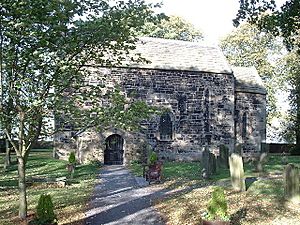
Battles between the Picts and the Britons of Alt Clut (Strathclyde) happened in 744 and 750. In 750, Kyle was taken from Alt Clut by Eadberht of Northumbria. The 750 battle between the Britons and the Picts happened at a place called Mocetauc. Óengus's brother, Talorgan mac Fergusa, was killed there. After this defeat, the Annals of Ulster said that Óengus's power began to fade. This might mean that Áed Find became king of Dál Riata and rejected Óengus's rule.
Historians have different ideas about how Óengus, Eadberht, and Æthelbald got along from 740 to 750. Some think Óengus and Æthelbald were allies against Eadberht. Or even that they ruled Britain together. Óengus would collect taxes north of the River Humber, and Æthelbald south of it. But this idea is based on a confusing old text. Many now think it was a mistake in the writing.
In 756, Óengus was fighting alongside Eadberht of Northumbria. They led armies to the town of Dumbarton. The Britons there agreed to their terms on August 1. But on August 10, almost their whole army was lost. This happened on the way from Ouania (now Govan) to Newanbirig. Some think Newanbirig was near Hexham.
Another idea is that Newanbirig was Newborough in Mercia. If Eadberht and Óengus were defeated there by Æthelbald's Mercians, it would fit a story. This story says that King Óengus founded the church at St Andrews. He did this to thank Saint Andrew for saving him after a defeat in Mercia.
The Story of Saint Andrew
The story of how St Andrews was founded is not from the same time period. It might include some legends. Old Irish records say that "Tuathalán, abbot of Cinrigh Móna," died in 747. This means St Andrews was founded before that date. It was probably founded by Óengus or by Nechtan son of Der-Ilei.
Most people believe the St Andrews Sarcophagus was made for Óengus. Later generations might have mixed up this King Óengus with another king of the same name from the 800s. The choice of David as a model on the sarcophagus makes sense. David was also a king who took power from others.
The worship of Saint Andrew might have come to Pictland from Northumbria. The worship of Saint Peter also came from there. Nechtan liked the cult of Saint Peter. The monastery at Hexham was dedicated to Saint Andrew. This link to the Northumbrian church might be written down somewhere. Óengus, like later kings from his family, is mentioned in a list of people who gave money to religious places connected with Durham. However, some historians say there is no definite proof that the worship of Saint Andrew existed before the 1000s.
Death and What He Left Behind
Óengus died in 761. He was probably over seventy years old. He was a very important figure in the politics of Northern Britain. His death is mentioned briefly in most old records. But a writer in Northumbria, possibly using a Dál Riata source, wrote more. He said, "Óengus, king of the Picts, died. From the beginning of his reign right to the end he did bloody crimes, like a cruel killer."
The Pictish Chronicle king lists say his brother Bridei became king after him. His son Talorgan also became king later, ruling from about 780 until he died in 782. Talorgan was the first son of a Pictish king known to become king, even if not right after his father's death.
An old Irish poem from the 800s is linked to Óengus:
Good the day when Óengus took Alba,
hilly Alba with its strong chiefs;
he brought battle to palisaded towns,
with feet, with hands, with broad shields.
It's hard to fully understand Óengus's impact. This is partly because we don't have much information about Scotland in the years after him. His connections to Ireland add to the idea that Scottish culture began to spread in eastern Scotland before Óengus's time. Many Pictish kings until 839 belonged to Óengus's family. This includes the 9th-century sons of Fergus, Caustantín and Óengus.
Historians have noted Óengus's important military wins. These wins happened over a large area. They also mention his support for culture and his founding of St Andrews. One historian, Keith Coleman, calls Óengus an "exceptionally powerful" Pictish king. Another, Murray Pittock, says he was more successful than any king before him. He united "all Scotia, Scotland north of the Forth, to his authority." This "foreshadowed a future united Scottish kingdom."
Kings from his wider family continued to rule the Picts. But they suffered a huge defeat by Vikings in 839. Óengus's great-grandson and many others were killed. This led to a time when many kings ruled for short periods and died quickly. This lasted until Kenneth I became king in 842. While Óengus might have shown what a united Scotland could be, Kenneth I is traditionally seen as the first King of Scotland.
|


